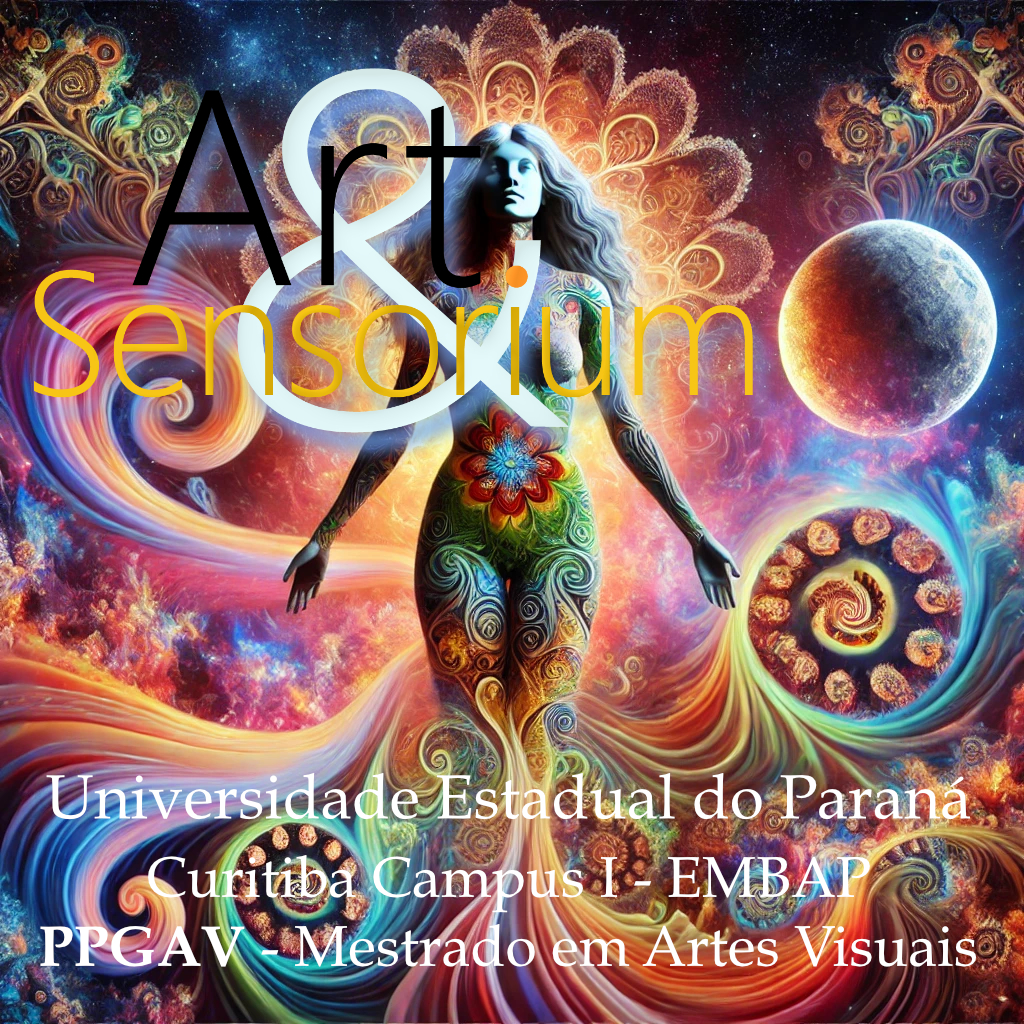POLÍTICA DA CONSCIÊNCIA E MEDIA IMERSIVA
UMA REVISÃO INTEGRATIVA
DOI:
https://doi.org/10.33871/sensorium.2025.12.10951Palavras-chave:
Awe, Art, Futurism, Shamanism, DesignResumo
Experiências inspiradoras e rituais estéticos podem induzir profundas transformações epistémicas, ao mesmo tempo que se cruzam com as estruturas de poder. Esta revisão examina diversos estudos de caso – desde rituais xamânicos amazónicos a artes em templos do antigo Egito, experiências surrealistas de sonhos, psicologia transpessoal e cibercultura de ficção científica – para compreender como as experiências planeadas de admiração e imersão podem transformar ou definir conhecimento e agência. Entre estes domínios, vemos um fio condutor: a "política da consciência" – a forma como os estados alterados e os sistemas simbólicos afectam as visões do mundo individuais e colectivas – entrelaça-se tanto com o mito espiritual, a realpolitik (o exercício do poder) como com os imaginários sociotécnicos. Destacamos exemplos de como as ecologias de arte-rituais sagrados e as técnicas mediáticas modernas servem como arquiteturas de transformação, aludimos às distinções entre experiências liminoides individuais, comunitárias e corporativas e, em seguida, exploramos como a admiração mediada pela tecnologia pode tanto elevar como minar a liberdade humana. O objectivo é elucidar como os rituais de admiração – incluindo os media imersivos emergentes – funcionam tanto como ferramentas de mudança epistémica como espaços de contestação política sobre o espírito humano.
Downloads
Referências
ARTHURS, Joshua. 2012. Excavating Modernity: The Roman Past in Fascist Italy. Ithaca, NY: Cornell University Press.
BARYSHNIKOVA, Daria. 2018. “Brion Gysin, Cut-Ups, and Contemporary Painting: Narrating Experience.” Frontiers of Narrative Studies 4 (S1): s126–s145. https://doi.org/10.1515/fns-2018-0035.
BELL, Catherine. 1992. Ritual Theory, Ritual Practice. New York: Oxford University Press.
BUCHANAN, Richard. 2001. “Design Research and the New Learning.” Design Issues 17 (4): 3–23.
CHIRICO, Alice, and David B. YADEN. 2018. “Awe: A Self-Transcendent and Sometimes Transformative Emotion.” In The Function of Emotions: When and Why Emotions Help Us, edited by Heather C. LENCH, 221–233. Cham, Switzerland: Springer.
CHIRICO, Alice, Francesco FERRISE, Lorenzo CORDELLA, and Andrea GAGGIOLI. 2018. “Designing Awe in Virtual Reality: An Experimental Study.” Frontiers in Psychology 8: 2351. https://doi.org/10.3389/fpsyg.2017.02351.
DEBORD, Guy. 1967. La Société du Spectacle. Paris: Buchet-Chastel.
DAVID, Jonathan, José C. BOUSO, Genís ONA, Nir TADMOR, Yair DOR-ZIDERMAN, and Evgeny PASTERNAK. 2024. “Ayahuasca-Induced Personal Death Experiences: Prevalence, Characteristics, and Impact on Attitudes Toward Death, Life, and the Environment.” Frontiers in Psychiatry 15: 1287961. https://doi.org/10.3389/fpsyt.2023.1287961.
DOHE, Carrie B. 2016. “Wotan and the ‘Archetypal Ergriffenheit’: Mystical Union, National Community and the German Psyche.” History of European Ideas 42 (4–5): 461–473.
DUNNE, Anthony, and Fiona RABY. 2013. Speculative Everything: Design, Fiction, and Social Dreaming. Cambridge, MA: MIT Press.
ESCOBAR, Arturo. 2018. Designs for the Pluriverse: Radical Interdependence, Autonomy, and the Making of Worlds. Durham, NC: Duke University Press.
GEARIN, Alex K. 2024. Global Ayahuasca: Wondrous Visions and Modern Worlds. Stanford, CA: Stanford University Press.
GELL, Alfred. 1992. “The Technology of Enchantment and the Enchantment of Technology.” In Anthropology, Art, and Aesthetics, edited by Jeremy COOTE and Anthony SHELTON, 40–63. Oxford: Oxford University Press.
HARAWAY, Donna J. 2016. Staying with the Trouble: Making Kin in the Chthulucene. Durham, NC: Duke University Press.
JAMES, William. 1902. The Varieties of Religious Experience: A Study in Human Nature. New York: Longmans, Green & Co.
JUNG, C. G. 1970. “Wotan.” In Collected Works of C. G. Jung, Vol. 10: Civilization in Transition, 179–193. Princeton, NJ: Princeton University Press. (Originally published 1936.)
KELTNER, Dacher, and Jonathan HAIDT. 2003. “Approaching Awe, a Moral, Spiritual, and Aesthetic Emotion.” Cognition and Emotion 17 (2): 297–314.
KELTNER, Dacher. 2023. Awe: The New Science of Everyday Wonder and How It Can Transform Your Life. New York: Penguin Press.
METZNER, Ralph. 2006. Sacred Vine of Spirits: Ayahuasca. Rochester, VT: Park Street Press.
MIKHAIL, Louis B. 1983. Dramatic Aspects of the Osirian Khoiak Festival. Uppsala: Uppsala University Press.
O’CONNOR, David. 2009. Abydos: Egypt’s First Pharaohs and the Cult of Osiris. Cairo: The American University in Cairo Press.
PIFF, Paul K., Pia DIETZE, Matthew FEINBERG, Daniel M. STANCATO, and Dacher KELTNER. 2015. “Awe, the Small Self, and Prosocial Behavior.” Journal of Personality and Social Psychology 108 (6): 883–899.
QUESNEL, Denise, and Bernhard E. RIECKE. 2018. “Are You Awed Yet? How Virtual Reality Gives Us Awe and Goose Bumps.” Frontiers in Psychology 9: 2158. https://doi.org/10.3389/fpsyg.2018.02158.
SATCHELL-BAEZA, Sophia. 2024. “‘Fathom Hell, Soar Angelic’: Are Immersive Art Shows Short-Circuiting Transcendence?” ArtReview, August 20, 2024. https://artreview.com/fathom-hell-soar-angelic-are-immersive-art-shows-short-circuiting-transcendence/.
SHANON, Benny. 2002. The Antipodes of the Mind: Charting the Phenomenology of the Ayahuasca Experience. Oxford: Oxford University Press.
SMITH, Carl Hayden. 2014. “Context Engineering Hybrid Spaces for Perceptual Augmentation.” In Electronic Visualisation and the Arts (EVA 2014), edited by Kia NG et al., 289–296. Swindon, UK: BCS.
STELLAR, Jennifer E., Amie M. GORDON, Craig L. ANDERSON, Paul K. PIFF, Gregory D. MCNEIL, and Dacher KELTNER. 2018. “Awe and Humility.” Journal of Personality and Social Psychology 114 (2): 258–269.
TAYLOR, Robert R. 1974. The Word in Stone: The Role of Architecture in the National Socialist Ideology. Berkeley: University of California Press.
TURNER, Victor. 1969. The Ritual Process: Structure and Anti-Structure. Chicago: Aldine Publishing.
Downloads
Publicado
Edição
Seção
Licença
Copyright (c) 2025 Art&Sensorium

Esta obra está licenciado com uma Licença Creative Commons Attribution 3.0 Unported License.
Autores que publicam nesta revista concordam com os seguintes termos:- Autores mantém os direitos autorais e concedem à revista o direito de primeira publicação, com o trabalho simultaneamente licenciado sob a Licença Creative Commons Attribution que permite o compartilhamento do trabalho com reconhecimento da autoria e publicação inicial nesta revista.
- Autores têm autorização para assumir contratos adicionais separadamente, para distribuição não-exclusiva da versão do trabalho publicada nesta revista (ex.: publicar em repositório institucional ou como capítulo de livro), com reconhecimento de autoria e publicação inicial nesta revista.
- Autores têm permissão e são estimulados a publicar e distribuir seu trabalho online (ex.: em repositórios institucionais ou na sua página pessoal) a qualquer ponto antes ou durante o processo editorial, já que isso pode gerar alterações produtivas, bem como aumentar o impacto e a citação do trabalho publicado (Veja O Efeito do Acesso Livre).


